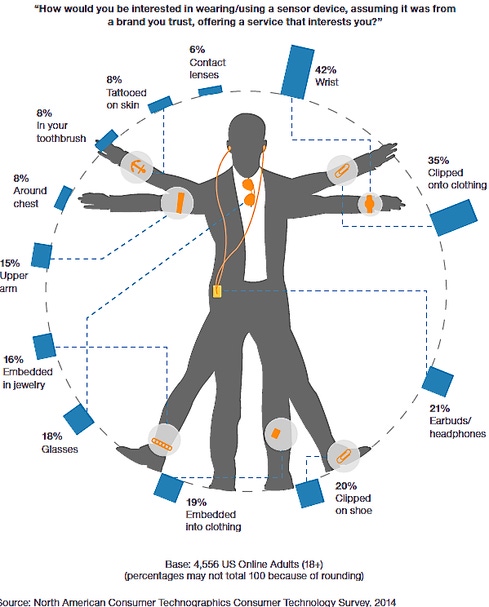The Apple Watch release in early 2015 will set the stage for wider enterprise adoption of wearables. Are you ready?

a tool for reengineering customer experiences via partner-designed experiences -- and your company might be one of those partners.
A digital guide to the physical world
The arrival of Apple Watch is not the only key trend to watch in 2015. Wearables will interact with the Internet of Things (IoT) to create new experiences for employees and customers. Smartphones remain an individual's key to unlocking contextual experiences wherever they are. But new physical experiences and behaviors – swiping, gesturing, haptic feedback, and body monitoring, among others – make wearables a potential digital guide to the physical world. A few examples include:
Access. Wrist-based access technologies don't require wearers to pull out a phone. Canadian startup Bionym recently received $14 million in Series A funding for its Nymi authentication band, which analyzes unique heart patterns to identify individual wearers. Nymi can be used to gain entry to rooms and buildings, to get rid of passwords on digital devices, or even to reshape customer interactions. A reference application for Nymi on the Salesforce Wear platform envisions giving the band to VIP high rollers at a casino instead of loyalty cards. Because the wearer is persistently authenticated, the casino can greet her by name, proactively deliver her favorite drink, and gambling chips.
Navigation. Navigating by smartphones has revolutionized travel, but in certain situations hands-free directions are a necessity. Ducere's Lechal smart shoes and Wearable Experiments' NAVIGATE jacket use haptic feedback to offer GPS guidance through subtle signals: The left or right smart shoe will vibrate and the jacket will squeeze your left or right shoulder to indicate turning directions. Apple Watch promises to do the same with signals to the wrist. For employees, haptics allow field workers to navigate completely hands-free, which is crucial in jobs like oil and gas industry engineers who work in places too dangerous to spend time looking at directions.
Payments. Wearables also hold great promise for mobile payments. Disney's MagicBand takes the place of a payment agent at its theme parks. The Lollapalooza music festival now uses wrist-based RFID payment bands. As use of Apple Pay grows, Apple Watch will play a role here as well. For employees (at your company cafeteria) and customers (at your retail outlets), payments will be an important part of your infrastructure to develop and support.
Work with the business to get wearables right
Planning for wearables requires deeper coordination between a company's technology and business leaders. Wearables involve a long tail of devices – worn on the wrist, embedded in clothing, sported as smart glasses – each with its own unique benefits for employees and customers.
For employee scenarios, IT must have a deep understanding of the needs of individual employees, how their work gets done, and how it helps the business – at which point tech managers can choose the right devices. For customers, tech managers will need to keep an eye on how consumers are interacting with wearables – particularly those that facilitate the kind of physical-world experiences that take maximum advantage of wearable devices and apps.
This will all get a lot more interesting when Apple Watch is available early next year.
The Internet of Things demands reliable connectivity, but standards remain up in the air. Here's how to kick your IoT strategy into high gear. Get the new IoT Goes Mobile issue of InformationWeek Tech Digest today. (Free registration required.)
About the Author(s)
You May Also Like







